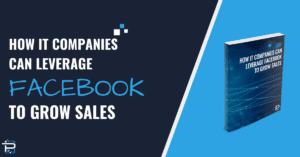There’s no longer a need to write an article on why IT channel partners need to focus on social media as an effective platform to communicate to customers and prospects. Social apps now consume >60% of the time spent on our phone, with the average person checking apps like Facebook more than ten times a day. The question now becomes how can VARs & MSPs best spend their time and resources within these tools. Our vote is on a single platform that is extremely undervalued based on the level of targeting and ability to do compelling account-based marketing: Facebook’s ad manager*.
* Update 2-15-2018: We no longer recommend this given changes over the past two years. Many of Facebook’s business targeting capabilities have been removed since this article was written. Additionally, LinkedIn has rolled out ad formats that work well for lead generation and ABM campaigns. We now recommend LinkedIn lead gen forms over Facebook ads. For more information, please view this article: LinkedIn Ads Lead Gen Forms
Why Facebook for B2B

LinkedIn has positioned itself as the go-to social platform for B2B. Recruiters, business development reps, and company executives all have individual reasons to go to LinkedIn. Additionally, LinkedIn has become an online resume for essentially everyone in the job-seeking market. LinkedIn has also taken steps in the right direction by creating “influencers” who create and share content directly through the platform. It is absolutely a channel that has significant value that cannot be ignored.
The main reason we recommend Facebook ads over LinkedIn is simple: value.* Consider your personal usage of LinkedIn over Facebook. We as humans have an almost natural reaction to check Facebook on an ongoing basis throughout the day. Those in Sales or HR may check LinkedIn frequently, but the vast majority of individuals may check LinkedIn once a day if they are very active users. The number of available impressions compared to the number of businesses looking to advertise and share content drive up the cost per impression and click at a quick rate – especially if you have a limited audience of whom you are targeting.
B2B Social Media Marketing is still P2P

Many may say that they don’t want to see advertisements within Facebook, and therefore form the opinion that ads and content should not be placed within Facebook’s news feed. The reality is that you must treat your marketing message as one that you would share with a friend. You wouldn’t interrupt your friend and tell them to look at something – you would share it with them if you found it compelling and meaningful. The same goes for Facebook ads – it should be something that a particular subset of people would find interesting and may inspire them to engage and take the next step.
The quality of data both in Facebook and LinkedIn is incredible. While LinkedIn data may be more accurate as it relates to their current position and employer, Facebook data has the ability to match demographics, interests, life events, AND work position/employer data*. When creating content and creative that speaks to a specific subset, understanding who they are and what their interests cannot be undervalued.
*LinkedIn now has interest groups available. The cost per click is still significantly (~10x) higher than Facebook.
Account Based Marketing in Facebook Ads

Account-based marketing surrounds targeting at the account level instead of the contact level. This often goes a step further and targets specific rules, such as IT or Finance professionals, within those accounts. This can be accomplished a few different ways within Facebook’s Ad Manager:
- Upload a Contact List – Facebook can integrate directly with marketing platforms or CRM’s and have target lists already identified by email address. Facebook checks against the email address and other criteria to find a match within their database. This is a great way to add Facebook as another touchpoint within an integrated campaign that may already include direct channels such as email.
- Identify Specific Companies – Facebook allows you to market to employees of specific companies within their tool. There may be duplicates, as this is based on both the Facebook business page as well as how employees entered the name of their employer. This is very effective for enterprise focused companies who have a limited number of firms they are focused on getting into. Specific roles can be included or excluded as part of the criteria here as well.
- Target Industries – While this is a more broad approach, it allows you to focus on specific industries and narrow down through other criteria such as geographic region and job title.
- Company Size – This is a somewhat limited filter at the moment, however, Facebook is consistently adding new ways to narrow down list size. At the moment, you are able to identify if you want to focus on small businesses or not. While this is extremely broad, it does give enterprise focused firms the ability to exclude small businesses from their target list and vice versa for IT channel partners who market to the SMB space.
Tracking Results With Facebook Ads

Facebook’s native reporting functions users provide all the standard metrics you’d expect to see such as impressions, clicks, click-thru %, and much more. Additionally, Facebook’s pixel allows you to place tracking code on your page to track conversions (i.e. someone fills out a form and end up on a “thank you” page) and to see if they revisited your site later on. For eCommerce businesses, their pixel allows you to understand the prospect’s journey from the point they viewed an ad to when they purchased. Getting a clear picture of how a campaign or ad performed is very easy with Facebook’s reporting platform.
For B2B companies, it’s critical that their CRM or marketing automation platform is configured correctly in order to get social traffic and interactions at a contact and company record documented. When set up properly, traffic and conversions from a Facebook ad can be recorded and scored at a contact and company record level. This, along with all of the other tactics within a campaign, can help VARs and MSPs get a line of site as to how successful their marketing efforts truly are.
Content is King…Still
Content still remains the primary success factor in marketing campaigns. This is even more so when it comes to social media when you are dealing with content overload at times. The quality and relevancy of your content will ultimately be what determines how successful the campaign is. Focus on creating meaningful content that actually matters to a specific audience, and target that audience using Facebook’s ad manager targeting tools, and carefully analyze the results in order to make effective adjustments.
Need help getting started? Check out our guide on how IT VARs & MSPs can better navigate today’s social channels.
